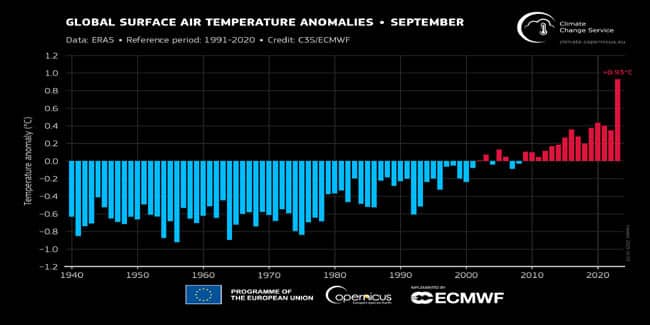Globally, September 2023 was:
|
Copernicus Climate Change Service (C3S), the European Union’s Earth Observation Program reports:
September 2023 was the warmest September globally in the ERA5 data record going back to 1940. The global average surface air temperature was 16.38°C – 0.93°C above the 1991-2020 average for September, according to the latest monthly bulletin from the Copernicus Climate Change Service (C3S), marking the highest positive anomaly for any month in the ERA5 dataset.
The month was about 1.75°C above the estimated average September temperature for 1850-1900, the pre-industrial reference period.
According to Samantha Burgess, Deputy Director of C3S, “The unprecedented temperatures for the time of year observed in September – following a record summer – have broken records by an extraordinary amount. This extreme month has pushed 2023 into the dubious honour of first place – on track to be the warmest year and around 1.4°C above preindustrial average temperatures. Two months out from COP28 – the sense of urgency for ambitious climate action has never been more critical.”
In Europe, September 2023 was the warmest September on record by an even larger anomaly – 2.51°C above the 1991-2020 average and 1.1°C higher than 2020, the previous warmest September in the region.
The global average sea surface temperature over the extrapolar oceans was also the warmest on record for September, at 20.92°C, and the second warmest for any month, only behind August 2023, while El Niño conditions continued to develop over the equatorial Pacific.
For the fifth month in a row this year, Antarctic sea ice extent remained at unprecedented low levels for the time of year. The average extent in September was 17.4 million km2, about 9% below the 1991-2020 average for September, marking the lowest annual maximum in the 45-year satellite dataset.
The Arctic average sea ice extent for September reached its sixth lowest annual minimum at about 4.8 million km2, 18% below the 1991-2020 average for September.
Every month the Copernicus Climate Change Service provides an update on temperatures, hydrology and sea ice, showing the current condition of the climate. The Climate Bulletins include charts and maps with the evolution of key climate change indicators, mainly based on C3S’s reanalysis dataset ERA5.



